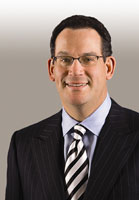Shopping malls are here to stay, at least according to David Simon, chairman and CEO of Simon Property Group, owner of more than 350 malls, outlet centers and other retail-oriented properties in the U.S., Europe and Asia.
Indeed, Simon said during a recent Wharton Leadership Lecture, his firm, the nation’s largest public real estate company, might consider making acquisitions again given that prices have recently fallen to levels last seen in 2002. The company, he added, is well positioned to weather a consumer downturn that has eliminated such familiar mall tenants as Wilson’s Leather, the Sharper Image and Steve & Barry’s.
Meanwhile, those who would write the American shopping center’s obituary have been proven wrong before, he noted. During the boom years of the 1990s, Time magazine declared that online shopping meant that malls would soon become extinct. And now, in the bust years of the early 21st century, a new crop of eulogists are predicting that the financial crisis will turn glittering spaces like the Houston Galleria or Indianapolis’ Circle Centre into premature relics. “I’m going to bet on the American consumer a bit more than CNBC and the others,” Simon said. “I think [retail] will bounce back a little bit faster and harder than most people say.”
Nonetheless, in a wide-ranging presentation that covered his career, his Indianapolis-based company’s growth into a global behemoth, and his views on both management and the future of retail real estate, Simon made it clear that his industry is facing real challenges, some of which will lead to significant change. “What’s going to happen … with retail real estate is that the strong retail will get stronger,” he said, adding that weaker retail will suffer, sooner rather than later. “Where it used to take years for … a bad mall to go out of business, I think it’s going to happen more quickly. For us, we know the winners and losers already. But the time [the losers] are going to be around [will] shorten.”
Simon’s confidence is based on his belief that his company is well positioned to compete in the more competitive environment of the post-crisis period. Simon Property Group includes top regional malls, premium outlet centers and super-regional malls acquired as part of the company’s 2007 takeover of the Mills Corp.
In general, Simon predicted, regional malls — such as the King of Prussia Court and Plaza outside Philadelphia and Southern California’s Fashion Valley Mall, both of which his company owns stakes in — will perform better than run-of-the-mill local malls. At the same time, the outlet centers and former Mills properties appeal to budget-conscious shoppers. But winning in the future, he added, is about improving even the best-located and best-marketed facilities.
A ‘Smarter Box’
“Long-term, the mall has to become a smarter box,” he said. “King of Prussia is a good example. King of Prussia has 150 stores. The average consumer goes to five or six. If we can figure out how to communicate to that consumer as [he or she] walks the mall, whether it’s ‘Hey, go to this store because you can get free this with every purchase,’ or ‘New merchandise is in,’ or that kind of stuff, I think it is going to facilitate loyalty. That’s what we’re working on.”
Simon has been through the industry’s ups and downs before. After getting his MBA from Columbia Business School, he spent several years on Wall Street “at the height of the M&A environment” during the 1980s. He worked at First Boston before following colleagues Bruce Wasserstein and Joseph R. Perella when they left in 1988 to start their own boutique investment bank. “My dad said, ‘Go learn from the masters,'” Simon said, referring to his father’s advice when asked whether he should join the fledgling firm.
In 1990, in another economic downturn, Simon left Wall Street to head back home to Indianapolis and what was then a family firm, Melvin Simon & Associates. “We were really at the height of the real estate workout” following the savings and loan crisis, he said. Like today, credit was tight and activity sluggish. “It really took three, four years to work that all out.”
Simon’s father had already made the company a major player in the shopping mall universe. When the younger Simon came into the business, with broad experience in mergers and acquisitions, he triggered a new age of aggressive growth. In 1993, he took the company public, renaming it Simon Property Group. “The capital gave us the ability to grow. We were trying to think of the retail paradigm in terms of scale, driving down our costs and capital. That led to a number of M&A activities that I’m well known for, [using] … a lot of the techniques I learned with Wasserstein and Perella and applying them to realty.”
Simon became president and CEO of the new firm in 1995. A year later, in the first big merger of two public real estate firms, Simon bought rival Debartolo Realty for $1.5 billion.
“Up to that point, no one ever had thought about, ‘Can you grow these companies in scale? Can you do typical M&A?'” Simon said. “That really created a platform where we ended up doing about $25 billion in deals. [In terms of leadership,] you’ve got to be an innovator, you’ve got to be aggressive. The best history of that really is … the M&A stuff that we did.” That included “one of the first hostile attempts” — a year-long battle to wrest control of the Taubman Centers mall empire from A. Alfred Taubman and his family. The battle ended, unsuccessfully for Simon, in October 2003. Now, he says, “we’re back at 2002 valuations. People should start thinking once again about how cheap real estate is.”
Simon’s recent acquisitions have included one-time titans such as Mills, part of a $4 billion 2007 deal; Chelsea Property Group, a $5.1 billion 2004 deal; and $1.5 billion worth of property from Rodamco North America in 2001. That last deal was struck just two months after the September 11 terrorist attacks during a time of significant economic and political uncertainty. “No one knew what the consumer was going to do; no one knew how you were going to finance anything…. It was a sign that sometimes you have to take an aggressive approach to creating value.”
Tough Decisions
But the aggressive managerial actions Simon has engineered since the financial crisis surged last year have tended to avoid the celebratory press conference. “With everyone being downgraded left and right, we’ve maintained our investment rating,” he said. “Our capital and liquidity is very strong, and I added to that.” Last year, the firm restructured its dividend payments from cash to mainly common stock. “I made a very tough decision,” he said. “We’re going to add another $925 million in free cash flow this year because we are preparing for the worst.”
Simon cited that decision, rather than any major takeover, as an example of his leadership. “I think, as a leader, you have a kind of dual personality. You have to be very aggressive, yet you can’t roll the dice where, if you make a mistake, you’re going to blow the business out. Shareholders by and large, believe it or not, want you to roll the dice and try to make the big play. Because … if they don’t like what you did, they sell the stock — and you’re left trying to figure out how to run the company. You want to listen to shareholders, but at the end of the day, you’ve got to rely on yourself.”
Today’s economy, particularly the volatility on both the income and debt side of the balance sheet, makes for an especially harrowing climate, Simon noted. “I don’t think anybody anticipated this. To some extent, we’re all scrambling. Some of us are doing it better than others.” Simon was helped by having been on Wall Street during the contraction of the early 1990s. “It’s easy to be a leader when you’re going to buy something and grow the business. But when you’re going to shrink or restructure, that’s when your leadership skills are really going to come to the fore.”
In the meantime, he said, a healthy balance sheet remains key, in good times and bad. “We’re not a retailer. We’re the landlord collecting rent. Absolutely, that job is harder today than it has been in the past. Retail has a lot of volatility. Seven of the top 10 tenants we had when we went public are no longer in business today, and yet we’ve been able to continue to grow our business because it’s the real estate that retains the value over the long term.”
Shareholders, he added, “have decided they’re going to re-equitize a handful of the best real estate companies on the market and the rest will go by the wayside.” He predicted his firm would be one of the survivors. “Results are … all that matters, frankly. What you did for investors is not that important. It’s what you are going to do going forward.”



